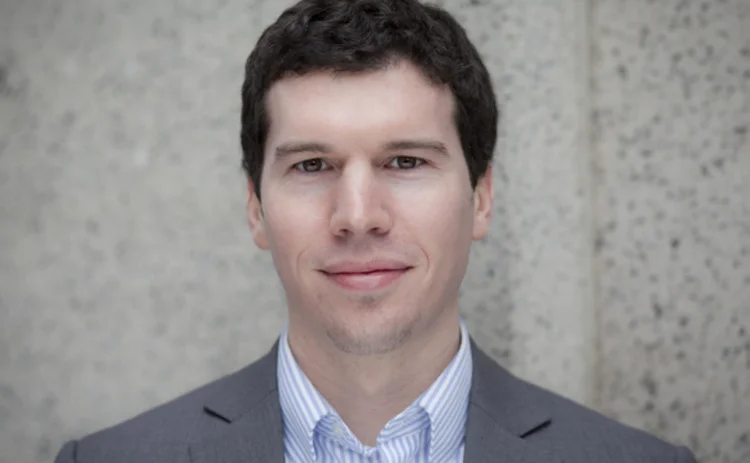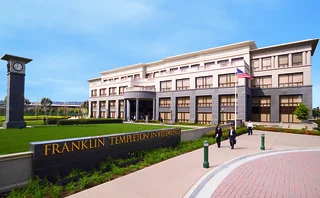Jake Thomases: Work: That Thing You Do

The word “work” has 31 definitions, according to Merriam-Webster. Richie Etwaru was riding a high-speed train when he began to question whether he’d been living the wrong one. Despite being miles from his office in Manhattan, Etwaru, now the COO of group technology, platform services, at UBS, was conducting a video conference on that train, talking to one person in New Jersey and another in Switzerland, using the train’s WiFi. He was far from work, yet he was just as much at work as he would have been in a cubicle.
“Work,” he tweeted afterward, “is a thing that I do, not a place that I go.” The comment was retweeted 40 times—a big deal for someone with only a handful of followers at the time. (He’s now up to 63,000). He knew he’d hit on something.
The self-described provocateur has made that concept a part of his public speaking appearances ever since. Work, he says, needs to be redefined in a fundamental way. Why are financial services employees, whose work is largely intellectual, driving to an office and sitting there for eight hours, then punching out completely until the next morning? One-company/one-building/9-to-5 is a paradigm that was created during the world’s industrial phase, when machinery for making products was housed in a factory and everyone had to operate it at the same time. Even during the computer age, white-collar workers were tethered to their desks because PCs were a bit too heavy to fit in their purses.
Enter Mobile
Mobile computing changed all that. Traders can check portfolios on their tablets. Clients can be emailed via smartphone. Not all work has to be done in situ anymore. Wise firms are already in the process of looking into which jobs fall under that umbrella, via a real estate modernization strategy or a mobile workforce strategy.
“If people are out on the road, do you really need office real estate that’s configured to support 100 percent of your employees at their desks, from 9 to 5, five days a week?” asks Jonathan Brasnett, head of global mobility at BT. “That’s not how it happens anymore.” In addition to telecommunications, BT is a provider of services surrounding bring-your-own-device (BYOD) strategies, and is an advocate for reexamination of traditional work norms.
Changing “work” from a location to an activity has considerable cost benefits for large sell-side institutions.
Changing “work” from a location to an activity has considerable cost benefits for large sell-side institutions. The 43-story Goldman Sachs building at 200 West St. in Manhattan cost a reported $2.1 billion to construct. Then there’s the ongoing cost of heat, electricity, insurance, security, maintenance, and everything else that comes with operating such a large building. Now imagine if a third of Goldman’s New York employees were able to work remotely. Could its headquarters be smaller, and therefore cheaper? Would its operating costs be lower?
Then there are the efficiencies gained by eliminating commuting time. The main reason Etwaru says he travels to the office is to “press flesh”—to network, get face time with his colleagues and co-workers, and exchange ideas in a social setting. For managers, such social interaction is important. For quants, it is not. Every hour spent in traffic is one less hour spent writing code.
A mobile workforce also extends the workday—potentially to 24 hours. “Ideas don’t come to you only when you’re in the office between 9 and 5,” Etwaru says. “Ideas come to you at 11:30 at night when you’re falling asleep or out having a cocktail with friends.”
A few months ago, a recent UBS hire asked for his cell number, then called him just before midnight with a trade idea. It was indicative of a generational shift. Young people who have grown up in the mobile era expect to be able to do anything, anywhere, at any time. Silicon Valley, one of Wall Street’s great competitors for talent, is ahead of the curve when it comes to creating a next-generation workplace. Big banks should consider the risk and regulatory implications, and then start thinking about work as a thing that people do, not a place where they go.
Only users who have a paid subscription or are part of a corporate subscription are able to print or copy content.
To access these options, along with all other subscription benefits, please contact info@waterstechnology.com or view our subscription options here: https://subscriptions.waterstechnology.com/subscribe
You are currently unable to print this content. Please contact info@waterstechnology.com to find out more.
You are currently unable to copy this content. Please contact info@waterstechnology.com to find out more.
Copyright Infopro Digital Limited. All rights reserved.
As outlined in our terms and conditions, https://www.infopro-digital.com/terms-and-conditions/subscriptions/ (point 2.4), printing is limited to a single copy.
If you would like to purchase additional rights please email info@waterstechnology.com
Copyright Infopro Digital Limited. All rights reserved.
You may share this content using our article tools. As outlined in our terms and conditions, https://www.infopro-digital.com/terms-and-conditions/subscriptions/ (clause 2.4), an Authorised User may only make one copy of the materials for their own personal use. You must also comply with the restrictions in clause 2.5.
If you would like to purchase additional rights please email info@waterstechnology.com
More on Emerging Technologies
Barclays carefully studying stablecoins
CEO CS Venkatakrishnan called the class of digital assets “broad and fascinating,” but urged peers to consider how it fits into the current banking deposit framework.
How an asset manager employs analytics to evaluate performance
Channing Capital, an institutional investment firm managing nearly $5 billion in assets, uses Aapryl to analyze its performance.
Nasdaq looks to ramp up tokenized securities efforts
Nasdaq CEO Adena Friedman wants to see tokenized securities come to the US markets “in a staged process.”
Franklin Templeton’s great DeFi migration
TradFi’s money and DeFi’s tech will inevitably combine, says the asset manager’s futurist-in-residence.
S&P’s $1.8 billion buy, an FIA restructure, a tokenization craze, and more
The Waters Cooler: CAIS creates CAISey, BNY deploys EquiLend, and more in this week’s news roundup.
When it comes to cybersec, the walls of separation are too high
Waters Wrap: Anthony examines some recent statements made by prominent cybersecurity experts and why those words might ring hollow.
Larry Fink: ‘We need to be tokenizing all assets’
The asset manager is currently exploring tokenizing long-term investment products like iShares, with an eye on non-financial assets down the road.
Examining how adaptive intelligence can create resilient trading ecosystems
Researchers from IBM and Wipro explore how multi-agent LLMs and multi-modal trading agents can be used to build trading ecosystems that perform better under stress.







